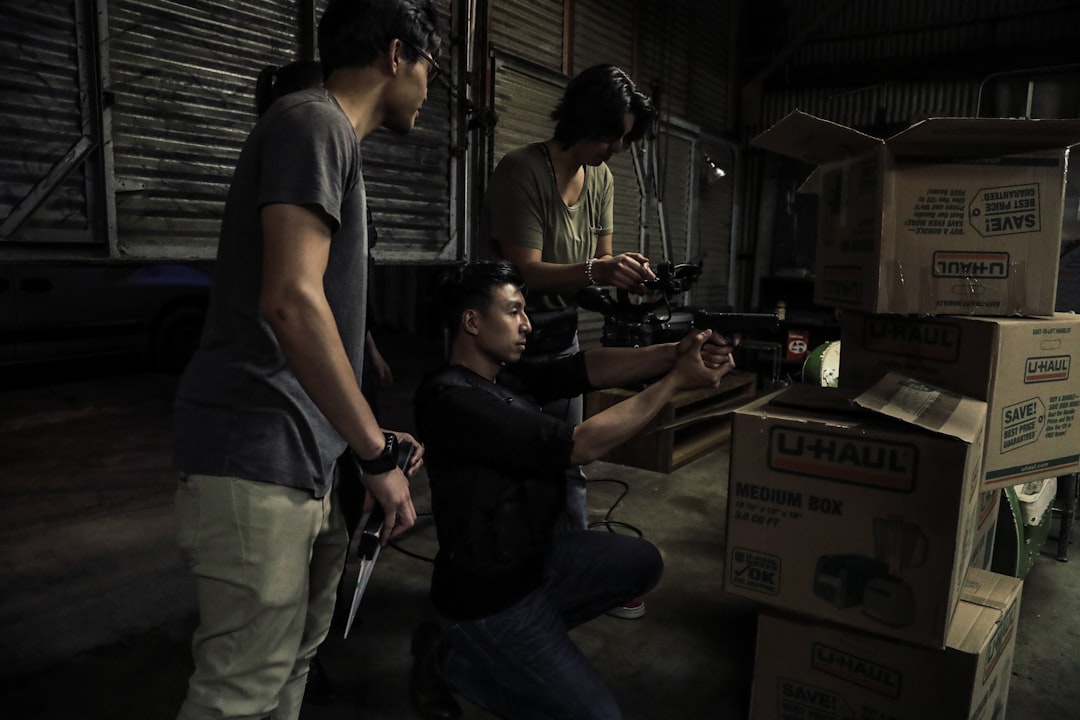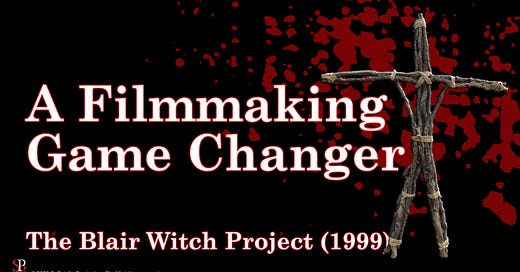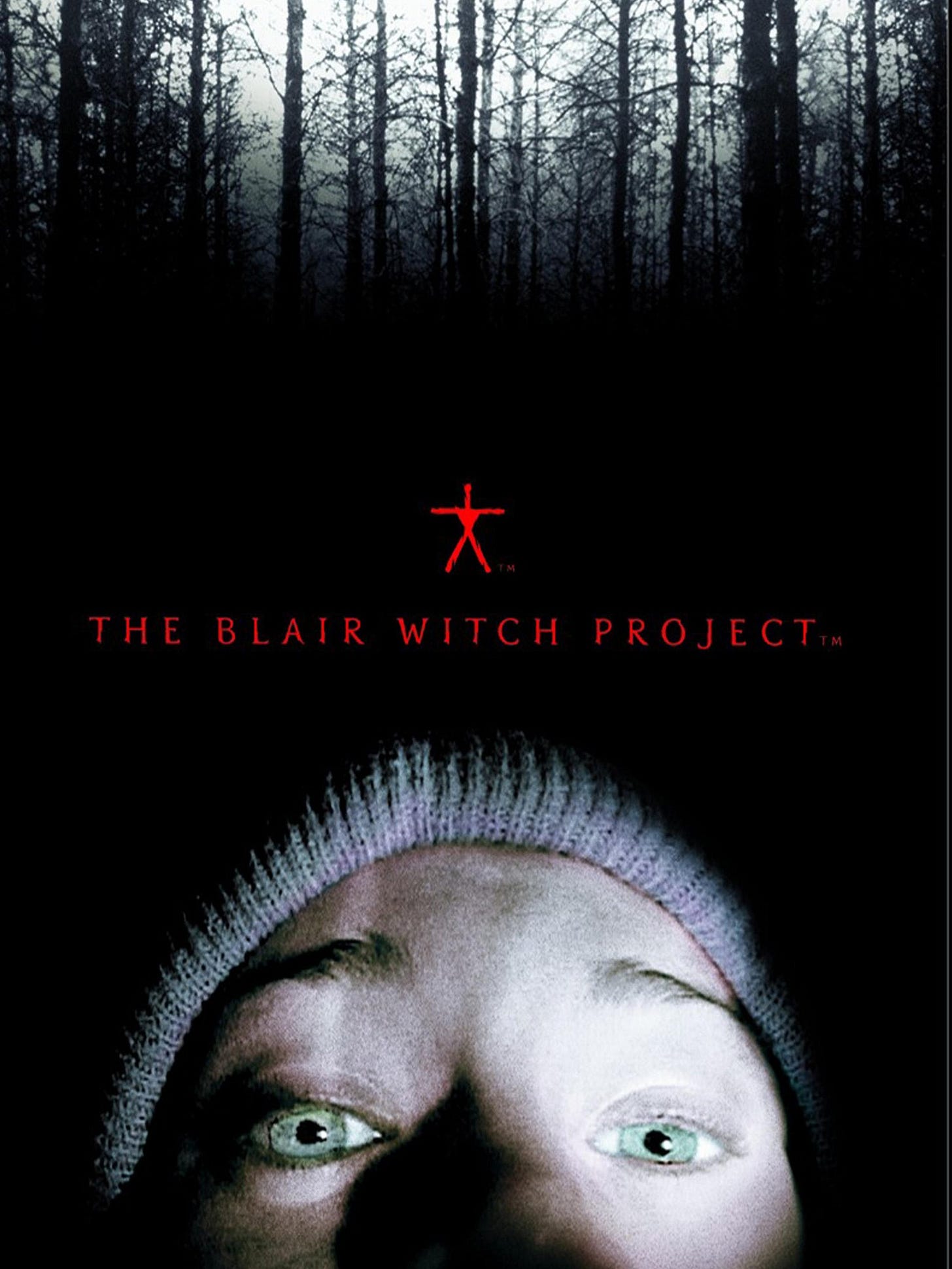One movie that I believe changed everything in the film marketing industry, is The Blair Witch Project, in 1999. The film came out while I was in college taking classes in film and media communications. I was fascinated!
It’s not that I felt the movie was a masterpiece. It’s the whole strategy around it that impressed me the most. I mean, the monster in the film was the sound of rocks at night, which you literally never see.
I had seen missing persons flyers on light posts and some random places, usually around the neighborhoods around San Diego State University where some of my friends lived. They mentioned a group of filmmakers who disappeared in the woods.
I was on campus one day, killing time between classes in the quad. There was a table set up with a couple people and they were promoting the film. They had the flyers and a bunch of the stick figures that appear hanging from trees in the film.
I still have it, even though I’ve moved homes countless times since. I took a photo of it in 2021 to create a graphic for an event. When the audio app Clubhouse came out, before it was open to the public, I used it to create a challenge event in the app with a few colleagues I’ve met in my mobile filmmaking ventures: Jason C. Marshall in Canada, Beraat Gokkus from Turkey who lives in France, and Brionne Olsen in South Africa.
Our challenge, accepted.
What if the film was made today (2021) instead of in the late 90’s? Could it be shot with smartphones and in the circumstances of the present time? How would they pull it off?
We basically put ourselves in the shoes of the three characters. Brionne played Mike running sound, Jason played Josh running the camera, and I played Heather. Beraat was more of an attendee to the event but we asked him to pitch in with ideas.
The first thing we had to overcome was getting lost in the first place.
Getting lost in the woods with phones that have GPS became an obstacle. While cell towers don’t provide much signal, GPS runs through satellites and it’s more dependable. It took a while debating to figure out how we could get lost. However, we were in the hills near Burkittsville, Maryland. And we don’t know for sure satellites would work.
We began to reason, just to be sure, that the hills were haunted. So it made sense, even with working GPS—that it would be unreliable.
I mean, even in urban areas, Siri has been known to have us driving in circles because it can’t figure out a parallel road, and there’s no haunting!
Once we overcame the difference between losing a paper map and GPS signals being out of whack, we were on our way to plotting the rest of the challenge.
We were a trio heading into the woods to shoot some B roll and a few sound bites for a documentary.
The guys, mostly Brionne, argued that we would not use smartphones for cameras. We would use a DSLR. He was talking about quality of the footage. He felt the directors would want high quality. We realized that the characters in the film were using a black and white CP-16 film camera and a Hi-8 digital video camera.
But imagine loading film canisters and batteries along with more batteries and tapes for the camcorder. Back then, they didn’t have the option we have now with smartphones. This was the point of the challenge.
Brionne mentioned unloading memory cards from a DSLR and editing on a laptop. I argued heavily over this. I began to sound like Heather at this point. We were going to carry batteries, a heavy DSLR just to capture B roll for a horror story documentary. Then we were going to bring a laptop too? Plus more battery power for that?
Jason began to reason between us, and we talked Brionne into agreeing to shoot on smartphones. We had no cell reception, it’s not like we were going to use them for anything else anyways.
We could watch what we captured on the phone, even begin to edit our documentary in our tent at night.
Then there was the issue of capturing audio.
Today, we felt we could use either an H4n recorder or bring a converter to plug a mic into a smartphone. Although, I reasoned, their main goal was to get B roll. We didn’t need to overthink the audio.
In the end, we concluded that The Blair Witch Project from 1999, could have been made today, using smartphones for cameras, possibly even audio. Everything in the story would have still worked out.
The filmmakers’ strategy was pretty genius, in my opinion.
When I went to see the film, it was a small theater at a mall and it was a late night showing. It was a spur of the moment thing. I remember being out with my Mom and we were having dinner at this mall when I noticed the film was showing. My mom was not at all interested in watching it, but she realized I really wanted to see it. So she waited for me to go in to watch it. The weird thing is that it was a small theater, very late at night, and I was the only one there.
Creepy right? The film itself was supposed to be the “found footage” that I had watched in the documentary on the Sci-Fi channel just a couple weeks before.
There were rumors by the time I watched the film, that it was not real. But it was a rumor. So when I was watching it, I wasn’t sure if I was watching a footage cut together from people who disappeared, who most likely were killed.
Now that I look back on it, I basically experienced the entire thing the way the filmmakers were hoping everyone did. The full experience. Like pranksters, they would be giggling in the background somewhere and laughing at my experience through their prank.
The filmmaking story of The Blair Witch Project.
The pranksters aka the filmmakers, were Daniel Myrick and Eduardo Sánchez. They both wrote and edited the film, which began production in late 1997. The original budget for the film was between $35,000-$60,000 but after post production, they spent between $200,000-$750,000.
I worked on a $1 million dollar film and it was still considered low budget in 2009. So while this budget may sound high for an indie film today, it was a very low budget during its time.
The Blair Witch Project premiered at the Sundance Film Festival in January 1999. Much like another film that surprised and shocked attendees in 2015: Sean Baker’s Tangerine, shot with iPhone 5S (I believe they used three).
But the story itself, even though it began production in 1997, was conceived in 1993 by both filmmakers, while they were students at the University of Central Florida.
Paranormal documentaries inspired the filmmakers and their strategy.
They were inspired to make the film because, during those days, there were a lot of paranormal documentaries on TV that were scarier than horror films.
I had a friend, in 1994 and 1995 who was constantly watching paranormal documentaries on the Sci-Fi Channel. I think some were on the History Channel as well. He had me watch many of them with him. I still don’t know to this day if he really believed everything in those documentaries or not.
Perhaps part of my attraction for documentaries comes from those days.
The filmmakers for The Blair Witch Project decided to create a film that was in the style of part documentary and part horror film. Ultimately, a mockumentary supernatural film.
They teamed up with Gregg Hale, Robin Cowie and Michael Monello to create a production company they named, Haxan Films. Named after a silent horror documentary film in 1922 by Benjamin Christensen.
They wrote a 35-page screenplay with improvised dialogue between the three characters. In 1996, they put out a casting call for actors who could improvise. A couple thousand actors auditioned for an improvised film. The auditions were very secretive with the actors. They would ask them random questions that had nothing to do with the story.
The characters.
Joshua Leonard was cast as “Josh” because he knew how to run a camera. Cinematographer Neal Fredericks provided Josh with the film camera.
The actors had no idea what to expect each day they were filming. They hoped that everything they were experiencing was part of the plan. Remember, they were told to improvise their dialogue. They interviewed townspeople without realizing some of the people they were interviewing were planted, and the rest were not actors.
Heather Donahue, Michael C. Williams, and Joshua Leonard used their real names as the characters’ names.
The characters were made to walk all day improvising. They were increasingly running out of food, on purpose. They were only told through written messages, a bit of what the day would entail. But it was scary for them because they were pretty much alone throughout the time they were in the woods.
The entire production shoot lasted eight days. The last day of shooting was on Halloween. They filmed about 20 hours of footage.
They edited the film to 81 minutes and submitted it to small festivals to get some feedback. They then submitted the final cut to Sundance Film Festival.
The film’s impact at the screening, around Midnight in January 1999, earned them distribution by Artisan Entertainment. The nationwide release of the film was July 30.

The ingenuity of indie filmmaking.
I feel that knowing the production process may inspire indie filmmakers today. Making an impact with a movie is much more than writing a screenplay, getting funding, hiring actors and crew, and filming. The twist is about getting creative with your strategy.
Thinking about this, while I was researching it, reminded me about another fascinating story in the history of film. How the original War of the Worlds radio program impacted the industry.
My fascination with storytelling is not so much about the stories themselves. It’s about the telling.
I believe filmmaking is the best form for storytelling because it has every tool available to create a masterpiece using the psychological play that films provide for effect.
The industry game changer of The Blair Witch Project.
The marketing for The Blair Witch Project, as I stated at the beginning, is fascinating. The filmmakers didn’t just market the film by keeping the truth about the footage not being real, from the public.
The film was perhaps the first film marketed solely by word of mouth and the internet. Even though I’ve managed to keep the stick figure, I have not managed to keep the VHS version of the movie. Even though I don’t have a VCR to watch it in, I wish I still had it.
Real or fiction?
They made a website in June 1999 that promoted the legend. An urban legend about the Blair Witch. The website had fake police reports about the missing students. There were online debates on whether the film was a real documentary or not.
The Curse of the Blair Witch was a mockumentary that I thought was a real documentary which I’d seen before the film. It aired on the Sci-Fi Channel on July 12. It aired as a real documentary with newspaper clippings and police reports.
Even though our group in the challenge concluded that the movie could be made in 2021 with smartphones, I am not wholly convinced the marketing strategy would work.
I’d love to sit down in my podcast with the original filmmakers and run through that scenario.
Support my writing with a paid subscription if you value writers, and the time and effort I make to create content for you and others.







